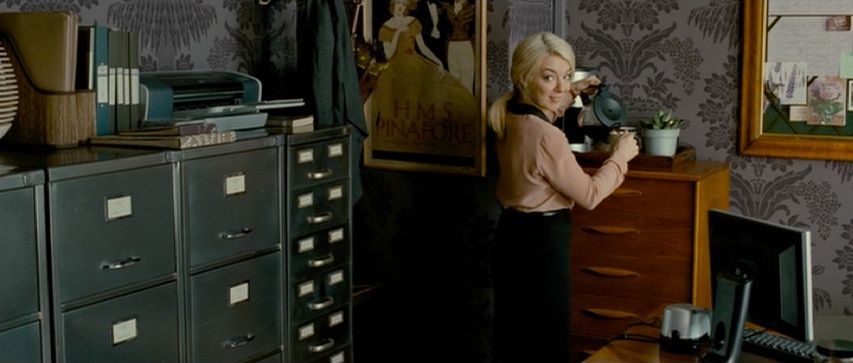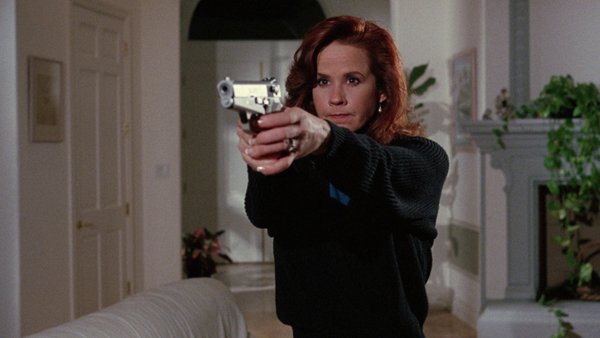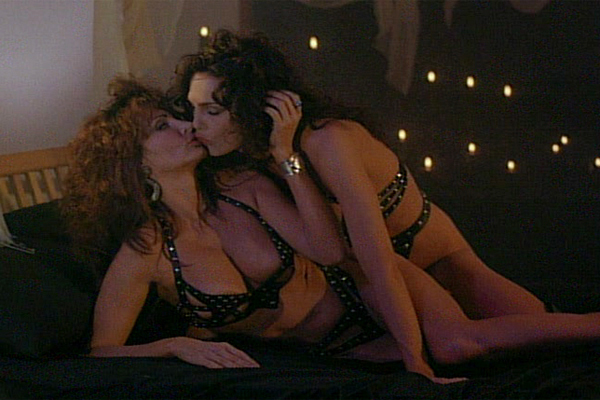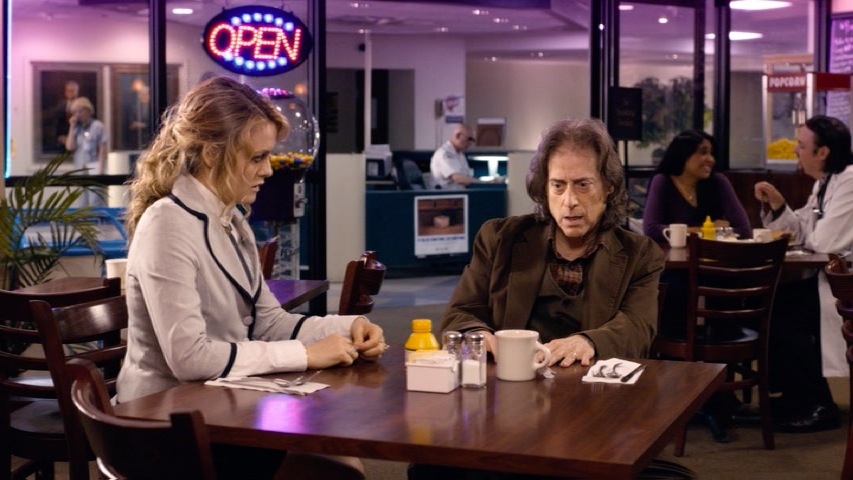« May 2016 | Main | July 2016 »
June 30, 2016
Napoli Napoli Napoli

Abel Ferrera - 2009
Raro Video BD Region A
Most of Abel Ferrera's films are about about people living in the margins of society. Even in this portrait of Naples, there is the impression that the city itself has a tenuous relationship with the rest of Italy. Ferrara skips between documentary and staged sequences. There are interviews with some inmate of a women's prison, social activists and local government officials. In between these scenes, there is the murder of a small time gangster, a dysfunctional family with an out of work father and a prostitute daughter, and a crowded cell of prisoners trying to make it through another day. Ferrera also includes older documentary footage of Naples in World War II, and city leaders in the 1960s trying to initiate improvements to the city.
The city is as much a character as any of the people who live there. The impression is that Naples is in the condition it is in due to a combination of ineffectual government, and residents forced into bad short term solutions for immediate problems. Everyone, regardless of class or profession, appears to be frustrated by the city. Like several other major cities, oversized apartment buildings were created for public housing, buildings that became instant slums. There are no jobs, no social services and no visible alternatives.
The fictional elements were written by Ferrera, along with Neapolitans Maurizio Braucci, Gaetano di Vaio, and Peppe Lanzetta, who also appears as brutal father whose favorite refrain to his family is that they should kill themselves. Ferrera's fictional family includes Anita Pallenberg as Lanzetta's wife and Ferrara collaborator Shanyn Leigh as the daughter. And while I would not dispute that there may some truth to Ferrara's view of the city and its people, I would have to think that Naples is not entirely the hell presented here. Anyone who has seen a fair sample of his other films would recognize that in the world of Abel Ferrara, the sun never shines, evil is everywhere, and everyone comes to a bad end.
I have yet to see Ferrara's film about Pier Paolo Pasolini, but there may be some similarity here. Pasolini's Rome, in his films and writings, is primarily the rougher part of the Ostia section of the city. Ferrara's Naples, likewise, ignores the tourist attractions for the inner city. There is a glimpse of optimism on the part of one of the female prisoners, looking forward to her release following time served for drug dealing. That would be the brief bit of sunshine in a vision of urban decay and hopelessness.
Posted by Peter Nellhaus at 03:45 PM
June 28, 2016
Chronicles of the Ghostly Tribe

Gui chui deng zhi jiu ceng yao ta
Lu Chuan - 2015
Well Go USA Entertainment BD Region A
Another Chinese special effects driven movie, that was seen in 3D by the mainland Chinese audience. And similar to Mojin, which I covered a couple of months ago, there a some similarities in the basic set-up, with the discovery of an ancient, alien civilization, hidden in a remote are in western China. There are also scenes that take a jaundiced view of China's more recent past. Somehow, the two films, adapted from the same literary source, were produced almost simultaneously, though Lu's film was the first to be in the theaters.
And it's the presentation of China's past that are intriguing. The opening scene introducing the hero, Hu Bayi, takes place in 1979. We see a man singing the kind of song that might have been heard in a musical approved by Mao or the Gang of Four, extolling the virtues of working hard on behalf of China. Lu cuts to a shot of Hu, exhausted, moving dirt from an archeological excavation site. A young woman follows Hu, acting as a kind of coach. Even shouting at someone on behalf of the revolution can take it toll as she faints, only to be replaced by another young woman. What I liked about this scene is that it initially appears as the imitation of a revolutionary musical, the kind that idealized Mao's proclamations, only to reveal a harsh reality.
A later scene, taking place a few years later, is of a China that has opened its doors in a very limited way to the west. Hu is taken to a restaurant that is primarily for westerners. The place is virtually empty. The main entree is steak. And there's a chubby guy, energetically singing in Chinese, dressed up like Elvis Presley. As it turns out, the Elvis impersonator is a long-lost friend of Hu's. But the scene is also of interest in what it shows of China's first faltering steps to accommodate westerners following the Cultural Revolution.
The exteriors were filmed in Gansu, in northwest China. Shots of the actors traveling by camel across desert and mountain regions are gorgeous. It's the countryside of China that is more awe inspiring than any green screen special effects.
The ghostly tribe are the descendants of people who were part alien and part human. Hu is revealed to have some kind of connection being the descendant of the prince who stopped the aliens from taking over earth about 10,000 years ago. There are these creatures that looks like a combination of wolf and stegosaurus that terrorize several characters, as well as little bat-like creatures. There are also some very large creatures that make brief appearances. Yet none of this is as compelling as the scenes of China still very much under the influence of the Red Guard.
Chronicles is Lu Chuan's first deliberately commercial film after a string of mostly critically acclaimed work. Of the two films adapted from the 2006 Chinese novel, The Ghost Blows Out the Light, Lu's film is marginally better. One of the unexpected credits is with the screenplay, with former independent filmmaker Bobby Roth, and his son, Nick, as collaborators. More riveting, is Lu's low budget debut, The Missing Gun, which bears some resemblance to Akira Kurosawa's Stray Dog. While contemporary Chinese audiences apparently can't get enough green-screen mayhem, there's more genuine excitement in following Jiang Wen as the small town cop in search of a thief.

Posted by Peter Nellhaus at 02:53 PM
June 26, 2016
Coffee Break

Nina Hoss in Barbara (Christian Petzold - 2012)
Posted by Peter Nellhaus at 06:41 AM
June 21, 2016
Shield for Murder

Edmond O'Brien and Howard W. Koch - 1954
KL Studio Classics BD Region A
Shield for Murder was based on a novel by William McGivern, who had also written the novel, The Big Heat. Fritz Lang's film came out in 1953. What made me think of that film was not the shared author of the two films' source novels, but Carolyn Jones' brief appearance in Shield for Murder. Normally a brunette, Jones is seen here as a blonde, a floozie sitting and drinking alone at a bar, her eye on O'Brien who comes in alone, trying to figure out how he can cover up another murder he committed. Jones seems to be made up to look like Gloria Grahame, the good bad girl of The Big Heat, so much so, that I started to wonder if Jones was the cheaper, in every way, "sister under the mink".
I found no information regarding how the responsibility for directing Shield for Murder was split or shared by O'Brien and Koch. It's possible that after appearing in two films helmed by Ida Lupino, that O'Brien decided to give directing a shot. One other film, Man-Trap from 1961, was directed solely by O'Brien. This is also Koch's debut directorial credit. Even with several credits directing both modestly budgeted studio films and television serial episodes, Koch is probably better remembered for his producer credits, most famously for Frank Sinatra, and being head of production at Paramount during the mid-Sixties.
O'Brien plays a corrupt cop who's suspected of murdering a bookie, and making off with the $25,000 the bookie was carrying. O'Brien's partner, John Agar, who looks up to O'Brien as a mentor, is sure O'Brien is innocent, just as he was with the several other people killed in the line of duty, but is forced to investigate this latest incident. O'Brien's hoping to buy a new house if the suburbs to share with young nightclub hostess Marla English. Especially for contemporary viewers, seeing O'Brien with English probably elicits thoughts of O'Brien being overly optimistic. A little research indicates that O'Brien, 39 at the time of this film, was extremely popular among female film-goers during this time.
Marla English is introduced with the camera tilting up from her feet, emphasizing the fishnet stockings she's to wear as a "cigarette girl" at the nightclub. One immediately imagined the kind of fish that English could catch with little effort. O'Brien immediately flies into a rage, forcing English to change clothing prior to a visit to his dream home. That house is so full of bric-a-brac and tchotchkes that it suffocates any opportunity to make the place seem more personal.
Visually efficient, but not stylish, with a story that may strike the jaded contemporary viewer as unoriginal, Shield for Murder should be seen for the performances of its cast. Especially when not speaking, but with the use of his facial expressions, one can see O'Brien's stage training and background in Shakespearean roles. Going from out of control anger to panic, I began to wonder what we might have missed in not seeing O'Brien as Macbeth. There is also the fun of seeing character actors, Emile Meyer as O'Brien's police captain, a young Claude Akins as a mob enforcer, William Schallert as an attorney, and an uncredited Richard Deacon helping O'Brien escape to Argentina.
The bar where Carolyn Jones meets O'Brien is also a restaurant that eventually gets a few hungry customers. Claude Akins and partner show up, trying to get the loot they know O'Brien stole of behalf of their boss. O'Brien, once again, lets loose with his anger, fiercely beating the two men. The film cuts to the faces of the other restaurant patrons, looking at the scene of violence in horror. One of the patrons, a man, has strands of spaghetti hanging out of his mouth. It's this scene that makes me think that Shield for Murder can be enjoyed for the visceral pleasures of watching a dirty cop in action, finally getting caught, yet simultaneously, if unintentionally anticipating some of Guy Debord's arguments in The Society of the Spectacle almost a decade in advance. Then again, it may not be a good idea to overthink a film that features a key character who reminds everyone that he's stone deaf, only to reveal a bit later that he had somehow gotten by in life as a street accordion player.

Posted by Peter Nellhaus at 03:51 PM
June 19, 2016
Coffee Break

Bette Davis and James Cagney in The Bride came C.O.D. (William Keighley - 1941)
Posted by Peter Nellhaus at 11:12 AM
June 16, 2016
The Midnight After

Na yeh ling san, ngo joa seung liu Wong Gok hoi wong dai bou dik hung Van
Fruit Chan - 2014
Well Go USA Entertainment Region 1 DVD
Battling a cold during the first few days when I attended the Far East Film Festival in 2014, I passed up the late screening of The Midnight After. Almost two years later, and Fruit Chan's film is now getting a DVD only release in the U.S. Now that I've seen The Midnight After, I can understand why there may have been little rush to make the film available stateside. The film serves as something of a a two hour metaphor for Hong Kong following the handover to mainland China, and as such, may be limited in terms how the film will be understood. Even setting aside the politics, those viewers who demand explanations for everything they see on screen will probably feel frustrated by the several unanswered questions.
A mini bus leaves from the main part of Hong Kong to an outlying city. While underneath the tunnel that links the two sections, other motor vehicles disappear. There are no cars or people on the other side, and no communications available. Several of the passengers die mysterious, violent deaths, bodies spontaneously crumbling or exploding. The remaining survivors stay in a small restaurant, trying to figure out what has become of the world they've known, and trying to work together in spite of various tensions.
One of several seemingly random messages received turns out to be the lyrics to David Bowie's "Space Oddity". While in no way intended on Chan's part, the scene with the survivors singing along to Bowie's song is inescapably affecting. Bowie's song is appropriate here as it's from the point of view of someone trying to maintain the illusion of having some control in a situation where there is total loss of control of the space ship. The scene with "Space Oddity" also provides a turning point in the narrative as there appears to be an unexplained shift of time, and the laws of gravity don't apply when the mini-bus is pursued by several large military vehicles.
Unlike some of the recent Hong Kong films that have been produced with companies from mainland China, The Midnight After is pointedly a film made by and for Hong Kongers. The best known stars here are to Johnny To regulars, Lam Suet and Simon Lam, although this is very much an ensemble piece. Chan's film is, in retrospect, one of the first of a new series of Hong Kong films that have expressed renewed anxieties about the handover, with more recent films being more direct about the concerns of being part of mainland China. For Fruit Chan, Hong Kong might be less of a country than a state of mind, one that is caught between a disappearing past, and a unclear, hostile future.

Posted by Peter Nellhaus at 05:40 PM
June 14, 2016
Hidden Fear

Andre De Toth - 1957
KL Studio Classics BD Region A
Probably the clearest indication that John Payne's time as a star of modestly budgeted action films was over can be seen in the posters for Hidden Fear. Not only is starlet Anne Neyland featured prominently, but is seen in a couple of suggestive poses not even in the film. Similar to Peter O'Toole being "introduced" in Lawrence of Arabia, disregarding several previous big screen roles, Ms. Neyland had been kicking around Hollywood for five years. 1957 turned out to be Neyland's banner year with featured roles also in Jailhouse Rock and the American International programmer, Motorcycle Gang. After that, Neyland went back to guest spots on television series for a few more years. The cheesecake promised in the Hidden Fear posters is barely fulfilled with a suggestive shot of Neyland in silhouette against a window, and a couple shots of her cleavage while in conversation with Payne in the Danish countryside.
Payne is mostly seen scowling his way, an American cop trying to clear his mousy sister who's been accused of murdering her boyfriend. It turns out that the guy's been part of a ring of counterfeiters. The sister's best friend is an American girl, played by Neyland, who also happens to be the occasional mistress to one of the ringleaders, played by Conrad Nagel. Alexander Knox is the guy who behind the counterfeit plates, an unrepentant ex-Nazi seeking revenge by creating two million dollars in fake Alexander Hamiltons to damage the economy of the U.S. and several European countries. The film takes place in Copenhagen, although I suspect it could have been filmed almost anywhere.
Anne Neyland is superficially attractive, no more so than several other young or youngish actresses of the day. More viewers will probably be infatuated with the Mercedes-Benz 300 SL that Neyland drives, later seen with Payne behind the wheel in a high speed chase seen through Copenhagen and beyond. The gull wing sports car is the real sexy co-star here.
Payne's journey into Copenhagen nightlife briefly indicates the Americanization of Denmark with a scene at the Texas bar, with a band playing a kind of variation of western swing, while at the Gold Digger bar, Payne walks into a crowd dancing to rock and roll.
De Toth wrote Hidden Fear with John Hawkins. Some of the same themes appear as in previous De Toth films, such as the main character being assumed guilty by a mob of citizens, as when Payne is chased though the streets of Copenhagen after being seen with a murder victim. There are a number of high angle shots, and shots of the characters by windows, visual motifs used frequently by De Toth.
While not credited, one of the cinematographers of Hidden Fear was Henning Bendtsen. Listed in IMDb and also, more critically, confirmed in the Danish Film Institute database, Bendtsen had also filmed the English language film film, Escape from Terror, starring Jackie Coogan, the first Danish film in color. Bendtsen also served as cinematographer for Carl Dreyer, ending his career with Lars von Trier.

Posted by Peter Nellhaus at 03:45 PM
June 12, 2016
Coffee Break

Sheridan Smith in Quartet (Dustin Hoffman - 2012)
Posted by Peter Nellhaus at 08:58 AM
June 09, 2016
Therapy for a Vampire

Der Vampir auf der Couch
David Ruehm - 2014
Music Box Films
I prefer the German title, which translates as "Vampire on the couch". The couch in this case is the one in the office of Sigmund Freud. The vampire, Count Geza, is tiring of his centuries old marriage, and is one the lookout for the reincarnation of the woman who turned him into a vampire. Taking place in a depopulated Vienna in 1932, most of the film is about a young artist, Viktor, who is employed by Freud to create illustrations of patients' dreams, Viktor's girlfriend, Lucy, who Count Geza is convinced is his former lover, and the vampire Countess Elsa, who employs Victor to create her portrait, to in effect provide her with a mirror image.
Whomever wrote the subtitles here needs should be credited. Too many films are mistranslated by people who miss the wordplay or context of some of the lines. Those with even general familiarity with vampire lore should appreciate it when Count Geza mentions "self-reflecting" and "a thirst for life" to the oblivious doctor.
There is nothing here as radical for its time, like Roman Polanski's introduction of a Jewish vampire in The Fearless Vampire Killers. Mad Magazine already has claimed the description of "humor in a jugular vein". What we have here is a fairly steady stream of chuckles inspired by the classic vampire legends, with two bickering couples, a snoopy landlady, and the short, lovelorn vampire's assistant. It's a handsome film which might have benefitted a bit from a little more money for the special effects. Those who love older vampire films, somewhere between F. W. Murnau and Terence Fisher, will be the ones who should most appreciate Ruehm's homage. One of my favorite moments, both poignant and funny, involves Countess Elsa, actress Jeanette Hain with a Louise Brooks hair-do, attempting to see her reflection by dabbing a cloud of face powder to no avail.
I would hope that Therapy for a Vampire does well enough to inspire making David Ruehm's earlier films available stateside. The showreels for the feature films and television commercials at Ruehm's website indicates a filmmaker with an inventive sense of humor. The guy loves old films and some of the visual cliches well enough to have fun with them, as is done here with gags involving the blood of some unlucky victims, and the vampire's ability at physical transformation.

Posted by Peter Nellhaus at 01:48 PM
June 07, 2016
Sorceress

Jim Wynorski - 1994
Synapse Films BD Regions ABC
Jim Wynorski is nothing if not industrious. Unlike several older protoges of Roger Corman who went on to make prestigious films, including several Oscar winners, Wynorski has carved out a path of making the contemporary equivalent to the older Roger Corman films - low budget films, shot quickly and profitably. Wynorski has also remade some of Corman's films, most famously Not of this Earth with Tracy Lords, and has also directed some seventy-odd films to date. For myself, the most interesting aspect of Wynorski's filmography is seeing the names of some of the actors he's worked with, actors who were considered stars for a brief period, and more typically fodder for the where-are-they-now articles that appear on websites or tabloid publications.
I wasn't familiar with Sorceress, but according to Ranker, it's considered Wynorski's eleventh best film. The basic plot seems like an episode of the TV series, Bewitched, with two rival witches trying to get their respective husbands set up to be the next partner at a law firm. What might seem like a comic premise is played straight for the most part. What reportedly has made Sorceress a cult film is the sexual content. In his commentary track, Wynorski discusses the trend in the early Nineties of the "erotic thriller", the kind of films that helped give one cable channel the name "Skinamax". This new blu-ray edition has footage that was not available on the VHS release or in some cable TV versions.

The big names here had their box office glory twenty years earlier. Linda Blair will forever be associated with The Exorcist. Edward Albert, son of Eddie Albert, had his moment with two films adapted from plays, with 40 Carats featuring Albert as the too young suitor of Liv Ullmann. 1973 also saw William Marshall in his second turn as Blacula. As it turned out Sorceress would be Marshall's last film appearance, appearing as the head of the law film that employs Albert and Larry Poindexter. Marshall keeps his dignity, Albert keeps a straight face, and Blair keeps her clothes on.
I don't think anyone watching Sorceress really cares who becomes partner at the law film. And I'm certain there was a sigh of relief when deranged gardner Michael Parks gets shot, although his performance might give a hint as to what we might have seen had James Dean been a better driver. The film opens with Julie Strain nude except for a diaphanous black nightie, slathering some kind of goo over her spectacularly enhanced chest. The other actresses are almost as well endowed. The witchcraft is just Strain and Blair reciting spells at their respective altars, but even that is besides the point. This is a movie for guys who like seeing Julie Strain get naked. We've got a twosome with Larry Poindexter, a threesome with Poindexter and Toni Naples, and most famously, a lesbian threesome with Naples and Strain in festish wear, seducing Rochelle Swanson. If you want to see Linda Blair undressed, you'll have to check out Chained Heat. I hope Swanson was well paid for kissing Larry Poindexter's butt.
Wynorski never mentions the budget, other than that it was limited, and that the film was shot in twelve days. Praise is given to cinematographer Gary Graver, best remembered for working with Orson Welles. There's nothing distinctly Wellesian here, though Graver does manager to make much of the film look like something from the pages of "Penthouse" magazine. Graver is praised several times for his craftsmanship. Filmmakers working with limited funds may find things to be gleaned from Jim Wynorski's commentary. I do kind of wish that the opening scene was filmed in 3D.

Posted by Peter Nellhaus at 03:38 PM
June 05, 2016
Coffee Break

Alicia Silverstone and Richard Lewis in Vamps (Amy Heckerling - 2012)
Posted by Peter Nellhaus at 11:35 AM
June 02, 2016
Something Big

Andrew V. McLaglen - 1971
KL Studio Classics BD Region A
The ghost of John Ford is never too far away in Something Big. In addition to having Ford company players Ben Johnson and Harry Carey, Jr. in the cast, Brian Keith is made to look somewhat like John Wayne as Nathan Brittles in She Wore a Yellow Ribbon. Carey even strums a few notes from that film's theme song. There's also Carol White speaking with a Scottish brogue, not quite Maureen O'Hara. Andrew McLaglen and screenwriter James Lee Barrett also include a cavalry regiment singing for Brian Keith, in honor of his retirement, before breaking out in a brawl. There is also the casting of former football player Merlin Olsen, large in height and girth, homage to the director's father, Victor McLaglen. Andrew McLaglen began his career as an assistant to John Ford on the The Quiet Man, and his first major film was McLintock!, virtually a transposing of The Quiet Man with John Wayne and Maureen O'Hara battling each other in the old west.
Stepping outside the genre expectations of being John Wayne's house director, Andrew McLaglen seems to have been at a loss trying to make a film that fit it with the newer westerns that turned out to be the last gasp of a once reliable genre. While peer and occasional collaborator ended up making his own Euro-western with Hannie Caulder, it would appear that McLaglen was responding to the two big westerns of 1969, Butch Cassidy and the Sundance Kid and The Wild Bunch. While "Raindrops are Falling on my Head" inexplicably became a hit song, and is one of the more memorable parts of Butch Cassidy, does anyone remember that Burt Bacharach-Hal David song that play while Paul Newman was cavorting with a bear in The Life and Times of Judge Roy Bean? The title song might have been less forgettable had the singer been Something Big star Dean Martin, rather than Mark Lindsay, cast adrift since leaving the mid-Sixties rock band, Paul Revere and the Raiders.
Where the Peckinpah connection comes in is with Dino getting hold of a Gatling gun, with the intent of robbing a legendary bandit's huge stash. Dino's gang of bandits all look grungy. No one looks like they've bathed or shaved. This is more or less a family friendly movie, so most of the violence is bloodless. When Dean Martin mows down a score of Mexican bandits with the Gatling gun, it's impersonal, lacking the catharsis or any meaning that came with Peckinpah's film.
In his New York Times' review, Vincent Canby described Something Big as ". . . one of those Pop period Westerns that's difficult to dislike even though it's not really very good . . .". The was Dean Martin's first film after Airport seemed to indicate renewed popularity. As Nick Tosches' biography of Martin made clear, Martin would prefer to watch a Western rather than act in one, but when it came to acting, Martin usually enjoyed playing cowboy. McLaglen, Barrett and Martin did much better earlier with Bandolero!, with Martin as the outlaw younger brother of James Stewart. Martin, as a failed outlaw in the newer film, resolves to do "something big" before surrendering to domestic life in Pennsylvania. Throughout the film, there are references to "something big", the film's attempt at a running joke. One of the other gags here is that Martin's dog is a little, unkempt, Scotch terrier.
Supporting players Denver Pyle, Joyce Van Patten and Judi Meredith provide some much needed gusto. Martin, for the most part, seems indifferent, expending little energy or even his well known charm in his performance. Whatever Andrew McLaglen and James Lee Barrett thought they were doing, Something Big turned out to be a misnomer of a title.

Posted by Peter Nellhaus at 12:55 PM
